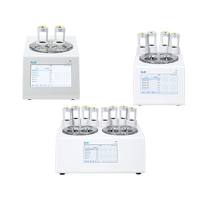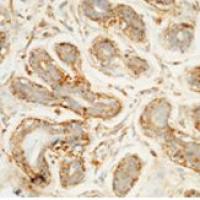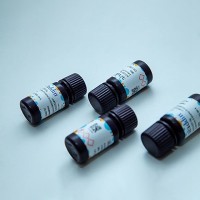噬菌体裂解液的制备
互联网
1. Inoculate 5 ml of lambda-broth in a glass culture tube with a single colony of an appropriate host strain of E. coli. Incubate the culture on a roller at 37°C overnight.
2. Transfer the culture to a 15-ml polystyrene conical tube. Collect the cells by centrifugation at 2,500 rpm for 15 minutes at 4°C.
3. Resuspend the cells in 2.5 ml of 10 mM MgSO4. Cells thus prepared are viable for several weeks if stored at 4°C.
4. Mix 106-106 phage with 0.1 ml of cells in a small glass culture tube. Incubate the mixture at room temperature for 5 minutes. Be sure the cells and phage are well mixed.
5. The source of the phage for this portion of the protocol is ideally 0.1 ml of an existing lysate diluted such that 0.1 ml contains from 105 to 106 phage. Alternatively, plaques from a fresh plate can be picked directly to the cell suspension using sterile Pasture pipettes or sterile toothpicks. In this case, add 1 to 5 plaques to 0.1 ml of cells.
6. Add 2.5 ml lambda-broth followed by 2.5 ml molten lambda-top agar (45°C) to the tube. Mix by quickly rolling the tube between your palms, and immediately pour over a fresh lambda-agar plate. Disperse the top agar evenly by swirling the plate. Allow top agar to solidify for several minutes at room temperature.
7. Incubate the plate right side up at 37°C. Plaques should appear in 4 hours, and lysis should approach confluence in 5 to 7 hours.
8. When lysis is just confluent, pipette 2 ml of lambda-diluent onto the plate. Scrape up the top agar overlay, and chop into a suspension using a glass spreader. Transfer the overlay and lambda-diluent to a centrifuge tube. If desired, wash the plate with an additional 1 ml of lamda-diluent and add this liquid to the centrifuge tube.
9. Centrifuge at 5000 rpm (Sorval SS-34 rotor) for 15 minutes at 4°C to pellet cell debris and soft agar. Decant the supernatant and filter sterilize using a 0.45 μm filter. Store in a sterile screw-capped tube, tightly capped and protected from light, at 4°C.
Prepare serial 1:10 dilutions from 10-1 to 10-8 (0.1 ml lysate in 0.9 ml lambda-diluent in a 1.7-ml microfuge tube). Use a fresh pipette tip for transfer between dilution tubes.
10. Prepare a lawn of cells in soft agar overlay as above (0.1 ml of cells suspended in 10 mM MgSO4 to 2.5 ml molten lambda-top agar on a fresh lambda-agar plate). Allow the top agar to solidify at room temperature for several minutes.
11. Divide the plate into 9 quadrants by marking with a sharpie. Label the quadrants undiluted, 10-1, 10-2, and so on through 10-8.
12. Spot 5-10 μl of lysate from each dilution tube to the appropriate quadrant on the plate. Incubate the plate up right at 37°C. Check the plate every few hours for the appearance of plaques. When individual plaques are visible in the high dilution quadrants, remove the plate and count the plaques. Calculate the titer of the phage lysate by the following formula (dilution in this case is expressed with a positive exponent):
| no. of plaques/vol. plated (ml)] x dilution = pfu/mL lysate | |
| Since phage greatly prefer fresh medium, it is convenient to prepare the lambda-media as follows: | |
|
lambda-Medium Bacto-tryptone 10.0 g NaCl 5.0 g Dissolve reagents in a final volume of 1000 ml dH2O. Divide into two 500 ml aliquots. For lambda-agar, add 5.5 g Bacto-agar. Sterilize by autoclaving. After autoclaving, add 5 ml 1 M MgSO4 to each 500 ml aliquot. |
lambda-Top Agar Bacto-tryptone 1.0 g NaCl 0.5 g Dissolve reagents in a final volume of 100 ml dH2O. Add 0.7 g Bacto-agar. Sterilize by autoclaving. After autoclaving, add 1 ml 1 M MgSO4. |
|
lambda-Diluent Tris base 1.21 g MgSO4 7H2O 1.20 g Gelatin 0.10 g Dissolve reagents in 800 ml dH2O. Adjust pH to 7.4 with HCl. Bring to a final volume of 1000 ml with dH2O. Sterilize by autoclaving. |
1 M Magnesium sulfate MgSO4 7H2O 24.65 g Dissolve in a final volume of 100 ml dH2O. Filter sterilize by passage through a 0.45 um filter. To prepare 10 mM MgSO4, aseptically add 1 ml 1 M MgSO4 to 99 ml sdH2O. |









